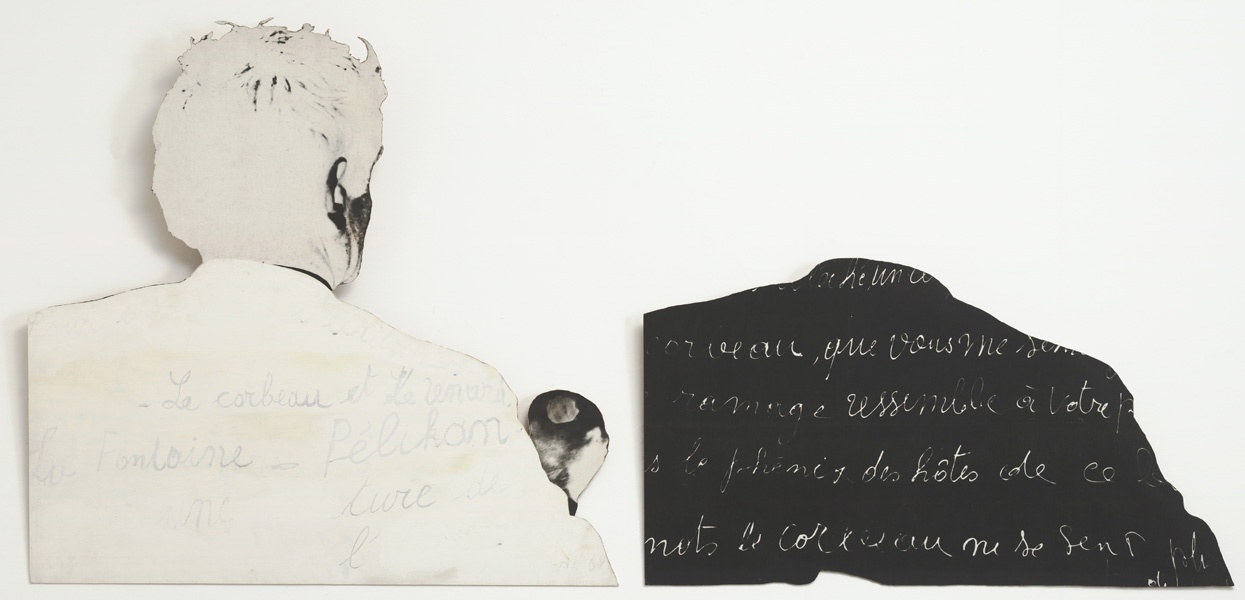
When it comes to historical reflection on poetic -language in art and art criticism, Marcel Broodthaers’s practice, deftly operating between text and object, meaning and its vehicles, is an indispensable point of reference.
But as Isabelle Graw argues in the six theses that follow, we should not only – and perhaps not even primarily – read him as a poetic artist whose objects functioned foremost as products of linguistic engagement. Rather, Graw locates the Belgian artist’s contemporary relevance in the continuum of his persona (which he calculatedly retooled as artist, poet, curator, among other roles) and its intersection with the vast but highly specific range of media he employed. In this perspective, Broodthaers appears less the enigmatic poet-artist than a “celebrity principle” pioneer.
Thesis 1: All that is linguistic in nature is exchangeable
To my mind, the excellent Marcel Broodthaers retrospective at MoMA was a powerful reminder of the topicality of the Belgian artist’s œuvre. Starting from the perspective of media theory, his art has been, and still is, enormously influential, not least because it fuses the most diverse artistic formats – object, image, film, photograph, book, painting, and text – in very immediate ways. Such fusion runs counter to the modernist-essentialist idea of the medium, as many observers have emphasized. Moreover, it demonstrates that no clear boundaries can be drawn between one media form and another, as any given one does encompass the other. The undoing of generic boundaries was manifestly the guiding principle of Broodthaers’s art from the outset. Consider, for example, his film “Le corbeau et le renard” (1967). It was not without reason that he projected this film onto a printed canvas painted with letters and words; and, moreover, that he chose to film objects such as glasses and eggcups positioned in front of the canvas. By consequence, cinematography, painting, object, and language blend into each other before our eyes, an observation that only underlines the heterogeneity of the work’s different constitutive media, which are, we might say, impure from the outset and intrinsically diverse. But what is more important, I would argue, is what Broodthaers made of this heterogeneity – it is here that his work differs from the œuvres of other intermedial artists of the time such as Robert Rauschenberg and Carolee Schneemann, who used indexical procedures to inscribe the traces of their selves along media’s disintegrating boundaries. Broodthaers, by contrast, used the transitions where the arts blur into each other for a reflection on value and the market, by consistently staging relations of exchange and substitution among things, words, numbers, letters, and persons. These relations make it possible for a film like “Le clef de l’horloge” (1956) to be explicitly classified as a poem, a “poème cinématographique,” while pictures are presented as postcards, shipping boxes labeled “Peinture” appear as stand-ins for paintings, classification and numbering schemes (as in the designation “Fig. 1”) declare objects to be exchangeable, and letters (such as the widely used initials “MB”) function as a synonym for the artist’s person (and indicate its compatibility with the commodity form). Such politics of substitution are a pervasive motif in Broodthaers’s œuvre. And they are deployed, I would argue, more or less explicitly to raise the question of value.
At first glance, it is the linguistic character of his works that enables and promotes such politics of substitution. There is virtually no picture or object in his œuvre that does not make reference to linguistic signifiers. Yet these -signifiers – and this is what sets Broodthaers apart from other exponents of Conceptual art such as, for example, Dan Graham or the members of Art & Language – stand out for their decidedly poetic quality. This is to say that as their linguistic meaning is displaced; they dodge the signification they carry in ordinary speech. The capital letter E, for example, which appears in several of his pictures, cannot be readily decoded. Though it seems to be a figure of sorts for the alphabet, underlining the semiotic nature of his work, its meaning remains inscrutable. The show at MoMA accordingly emphasized the poetic dimension of Broodthaers’s œuvre, conceiving of his objects, pictures, and installations as poetry translated into realities in space. But it should be added that he not only endowed poetry with extension in space, he also cast it into real objects, effectively making it a product compliant with the commodity form. It is true that, despite his demonstrative abandonment of his identity as a poet in 1964 and his adoption of the new role of visual artist, Broodthaers remained an “artist-poet.” And while the emphasis on the poetic quality of his work rightly focuses on the aspects therein that defy verbalization – effects achieved via the means of language – such a perspective tends to distract from the Institutional Critique performed by Broodthaers as evidenced by, not least, his “Musée d’Art Moderne, Département des Aigles” (1968–72), which was a central point of reference in the early 1990s, especially for the rising generation of artists associated with “Kontext Kunst.” To describe him as an “artist-poet” thus presents him as the prototype of the artistic self-image that is currently popular among those young Anglophone artists who describe themselves as “poets.” And this general enthusiasm for the poetic Broodthaers tends to overshadow the fact that poetry, in his practice, was neither pure nor any less compromised by -commercial relations than other art forms. Rather, by demonstratively translating poetry into material works of art, Broodthaers adapted them to the commodity form and thus potentially endowed them with value.
Yet this common denominator of his work – language – is also the premise that makes the relations of exchange and substitution between, say, painting and poetry in the “Peintures littéraires” (1972–73) possible: relations of exchange and substitution that, we might say, put value into play. It is telling that the selection of words printed on the canvases in the “Peintures (Série l’art et les mots)” (1973) as a lexicon of painting of sorts includes – besides terms such as “L’Image,” “Le Sujet,” “Le Style,” and “Couleur” – several occurrences of “Prix” (price), as though to remind the viewer of the pictures’ market value as well. Immaterial words have taken the place of material painting, while linguistic signifiers are translated into material pictures, a symbolic operation of substitution by proxy that, as the philosopher Jean-Joseph Goux has persuasively argued, puts the metonymic structure of any value-generation on display: “Whether this exchange involves comparison, substitution, supplementation – or translation and representation – value enters into it.” As Goux adds, Marx already pointed out that nothing is valuable in itself, that the value of one commodity finds expression in the body of another. Goux’s assertion that value resonates in virtually any linguistic substitution may be unduly totalizing. What is crucial, for our context, is that Broodthaers’s art enforces a specific form of relation of exchange and substitution between immaterial words and material objects and pictures that ineluctably raises the question of value.
Thesis 2: Broodthaers is the market-reflexive artist par excellence
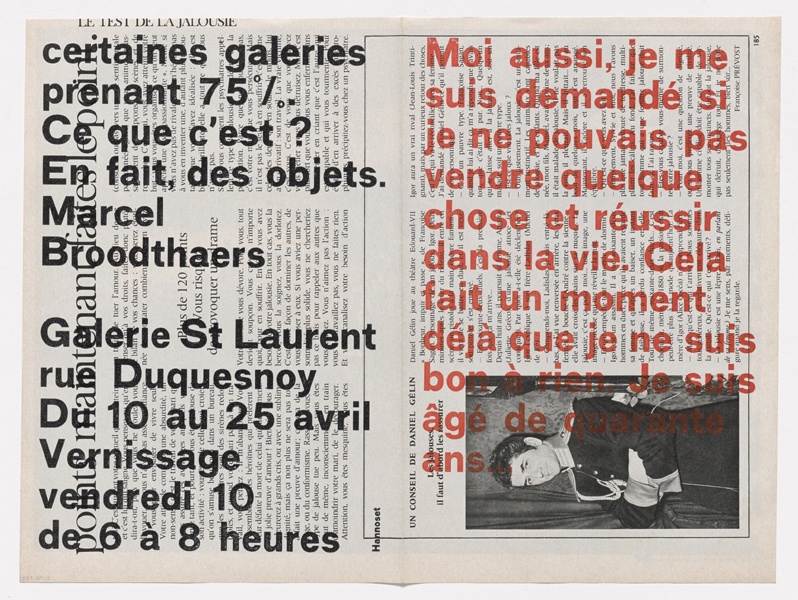
When Broodthaers enacted his conversion from poet to visual artist in 1964, he staged it as a transition motivated primarily by economic considerations. The legendary text printed on the card inviting his audience to his first exhibition, “Moi aussi, je me suis demandé …” (1964) cuts to the chase: it is a matter of “selling” and “success.” The artist wonders whether he might not for once in his life amount to something. To do so, he reasons, he would need to produce something “insincere.” Apart from the fact that this portrait of his artistic practice as a purely commercial venture is surely a deliberate exaggeration, the (ostensible) confession of insincerity suggests that his production should be put in quotations from the very start: there is no way to tell whether he is sincere about his art-making or merely “insincerely” playacting the part of artist. This gives his audience license to take his work seriously while also not taking it too seriously – a refreshing contrast with all those artists, then as now, who are inclined to take not only their work but also themselves very seriously.
Nor did Broodthaers make any effort to communicate his concerns and noble intentions with the greatest possible authenticity and credibility, which is currently often the purpose of press releases and other didactic material. On the contrary: in a gesture that would have certainly provoked back then – even if one has gotten used to it in recent years, most recently via the activity of DIS and related entities – he presented himself as a jaded yet highly cunning strategist, deliberately creating the impression that his objects were made solely with a view to their commercial viability. The text of the invitation card also mentions that it took him less than three months to make the pieces on display, another affront to the traditional and still widely held notion that artists must labor hard and long to earn institutional recognition. Then again, Broodthaers’s riding roughshod over the conventional rites of passage may also be read as an indirect avowal of his allegiance to Conceptual art, though he would subsequently regard it with growing skepticism. But the very fact that the statement on the invitation card forms an integral component of his practice identifies the latter as conceptual.
Finally, the fictional account of his conversion to visual art avers that, of all people, it was the owner of the gallery who classified his first attempts as “art.” The anecdote is effectively a statement on value in general. The message, once again, is that works of art have no intrinsic value, that their value is constitutively relational – in short, that it is a “social relation,” as Marx aptly put it. Notably, the value the gallery owner ascribed to Broodthaers’s objects was first and foremost symbolic, though it might prove capable of translation into market value.
Thesis 3: His view of himself as an “ouvrier de luxe” is very up to date
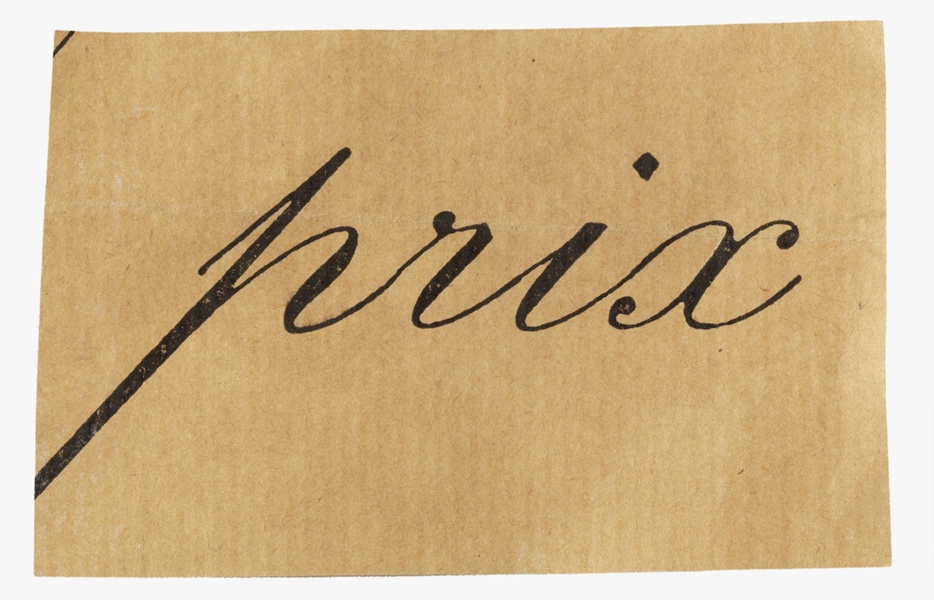
As these examples illustrate, Broodthaers was unusually clear-eyed about the art market; like Baudelaire before him, he perceived its -realities “without any illusions” (Walter Benjamin). Hence the provocative remarks he offered with some regularity, claiming, for instance, that “the aim of all art is commercial. My aim is equally commercial.” In light of such statements, it is hardly surprising that he was often seen and criticized as a “cynical pessimist,” as Benjamin Buchloh notes (without endorsing the assessment). Now as then, the charge of cynicism is a popular if blunt weapon, often used to bash artists who are sensitive to market conditions, a moralizing reproach usually meant to personally discredit the artists in question. But consider that “cynicism,” strictly conceived, describes an attitude of caustic mockery and deliberate disdain for and violation of social conventions, and it no longer feels quite so reprehensible. Maybe we don’t need to tolerate and occasionally admire this quality in artists only once they are dead (see the posthumous celebration of artists like Warhol and Kippenberger).
Especially in his later years, Broodthaers increasingly posed as a Warhol-style “commercial artist,” as when, on the occasion of his exhibition “Le privilège d’art” in Oxford (1973), he proclaimed his belief that the only legitimate definition of art was based on “one constant factor – namely, the transformation of art into merchandise.” In other words, according to Broodthaers, the commodification of art was a given, though he never discussed whether the artwork was to be considered a special kind of merchandise or a commodity like any other. Unlike many of his fellow Conceptualists, who either imagined themselves to be altogether outside market conditions or sought, often in vain, to neutralize the work’s compliance with the commodity form by putting the emphasis on immateriality, Broodthaers certainly gave the impression of regarding art as a marketable product and of considering the artist as operating in a capitalist market. Moreover, the artist, as he understood him, was an “ouvrier de luxe,” a worker making luxury products, certainly a pretty lonely stance to take in the 1970s. Yet the much-discussed structural transformation of the art world that, since the 1990s, has increasingly merged the spheres of art and luxury lends some plausibility to this virtual identification of art and the luxury industry. In an “economy of enrichment,” as Luc Boltanski and Arnaud Esquerre aptly describe the new economic situation, the singular work of art has indeed emerged as the prototypical luxury product, inspiring the conventional luxury industry to enhance its wares with ploys such as limited editions and customized production.
Similarly, some of Broodthaers’s deliberately overdrawn statements now read as positively prophetic in light of the expanding global art market, which serves as a model for the neoliberal economy when it comes to deregulation and social inequality. For example, in 1975, he claimed the growing overlap between artistic and commercial values – a prescient diagnosis if you consider the significance of formerly artistic values such as creativity and self-determination in the contemporary economy.
Thesis 4: Broodthaers is a self-brander, but there’s a catch
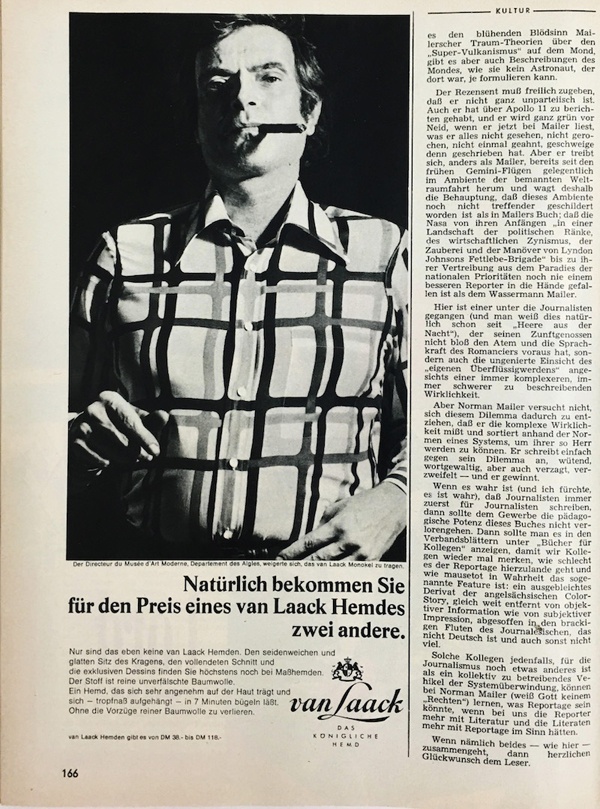
Broodthaers’s career also illustrates how an artistic practice that crosses media boundaries and sets genres into interrelation with each other leaves art increasingly dependent on the mise-en-scène of the artist’s persona. I use the term “persona” here in the sense it has in anthropology, where it designates a role or “ritual mask” (Marcel Mauss) that tends to be indissolubly bound up with the individual’s true being. There are numerous works by Broodthaers – first and foremost, his films – whose subject is this persona balancing on the fine line between authenticity and staging. Consider, for example, “La pluie (projet pour un texte)” (1969), a work that fuses text and film in its very title and that moreover shows Broodthaers himself in the act of writing. We see him sitting at a table or, more precisely, at one of the art-shipping crates that he put to various uses; he dips his pen into an inkwell and writes on a sheet of paper, only to watch rain (or, rather, water being poured over the table) blur and efface the letters. The artist’s hair, too, is dripping wet, and he looks as if he could use a towel. The washed-out writing must be read as a metaphor of withdrawal, since it enacts, in literal form, the withdrawal of meaning that is often the objective of Broodthaers’s art. But this film in which he stars also attests to the growing need for the artist to adapt to the emerging media society of the 1960s and its “star system.” Staging himself as a persona in his own work, he thus invests his work with his own (potential) celebrity.
There are numerous other examples that illustrate how Broodthaers – comparable, in this regard, to artists such as Andy Warhol and Piero Manzoni – intuitively understood the growing significance of self-dramatization and self-marketing in a media society and responded accordingly. In 1971, he agreed to model for an ad for the shirt brand van Laack (then owned by the collector Ralf Hoffmann) that ran in Der Spiegel. What seemed still relatively unusual then – a “poet artist” with a fairly hermetic œuvre as an advertising vehicle for a mainstream brand – is rather common today. It is quite natural to see an artist who writes (like Seth Price) or a poet-artist (like Karl Holmqvist) posing in a Brioni ad. Yet whereas Price and Holmqvist are shown to adopt rather pensive or sensitive poses in their Brioni suits, Broodthaers faced the reader with a striking pose of confidence, combining the tight-fitting shirt – the large check pattern recalls the grids of Mondrian’s paintings – with a cigar in his mouth. A little later, in his thrift store painting “Untitled (General with Cigar)” (1970), he would put the same cigar, Asger Jorn-style, into the mouth of the fascist general Pétain. The accessory exudes a kind of gentlemen’s-club atmosphere, highlighting the art world’s conventional social mode of the time (male bonding, no women allowed). In other words, Broodthaers leaves no doubt that, as a heterosexual male artist and cigar smoker, he participates in the questionable rituals of a scene that, though opened up for admittance to some formerly excluded groups, remains exclusionary in many ways even today. On the other hand, as the copy accompanying Broodthaers’s picture in the van Laack ad notes, he refused to wear the brand’s signature monocle. So even as he allowed himself to be used as an advertising vehicle, he insisted on inserting a token of his resistance. Needless to say, the small rebellion ultimately benefited the brand by associating it with large-mindedness: a van Laack, the ad suggests, is the right shirt for a real artist, a man who always stays true to himself.
When Broodthaers later included the ad in “Ma collection” (1971), a sort of collage atlas of his œuvre in miniature, he added a handwritten remark: “What should we think about the relations that link art, advertising, and commerce?” The focus here is once again on the “relations” of exchange and substitution between the artistic and commercial spheres, between art and advertising. Broodthaers’s note hints that Conceptual art in particular had proven adept at integrating advertising techniques and self-promotion. A rule of thumb might be: the more ephemeral a work, the more the artist himself will draw attention as the proxy for his project. A salient early example of this phenomenon is Mallarmé, a central influence on Broodthaers, who, during his lifetime, was the object of positively cultic veneration fueled in no small part by the rumor that he had created an absent secret masterwork no one had seen.
In Broodthaers’s own case, I would argue, another episode was crucial in shaping his view of the artist as a product: his encounter with Manzoni in 1962. For his “living sculptures,” Manzoni imprinted his signature on the bodies of models or visitors to his exhibitions. Declaring living people to be works of art, the intervention also turned them into allegories of the heightened stature of the artist’s own body, which, in a media society, becomes an art object in its own right and a commodity of sorts. Interestingly, Broodthaers himself, visiting an exhibition of Manzoni’s work in London on February 23, 1962, had been labeled an “œuvre d’art authentique et véritable.” The accompanying certificate bears a handwritten note by Broodthaers: “Je suis employé” (I am employed) – in other words, he saw himself as having been conscripted into the service of art (or, and this is the same thing, into Manzoni’s service). Yet such employment was premised on Broodthaers’s conceiving of himself as a work of art and presenting himself in appropriately object-like fashion. The emblem he developed for this commodification of his person was the signature “MB”; comparable to John Knight’s “JK” logo, the initials are the sole motif in many of his works. The picture “Gedicht Poem Poéme, Change Exchange Wechsel” (1973) tallies these MBs in sums, gesturing toward the value-generating function of artistic authorship. It is the signature that ties the work back to its author, and even further: that brings the author into being as such. At the same time, abbreviations like MB and JK are also standard commercial practice; many company names and brands are acronyms or initialisms – think of the cigarette brand “HB” in this respect. In this perspective, the signature MB contains the seed of the transformation of artistic practice into branding pursued today by artists like Alex Israel and many others. We might almost call Broodthaers’s signature MB a form of self-branding avant la lettre. Yet unlike those artists who, in their emulation of brand marketing, bargain away all hope of being more than just brands, Broodthaers also developed techniques that don’t allow for this reductivist understanding of his work and complicate any instrumentalist approach to it.
Thesis 5: Broodthaers is a discursive artist who pursues the withdrawal of meaning, and this, in turn, facilitates his art’s commodification
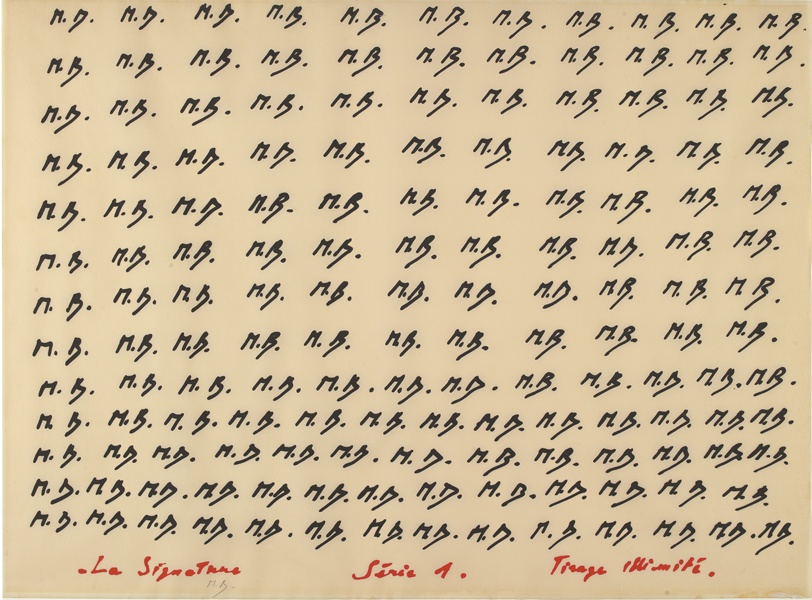
Although Broodthaers’s œuvre is semiotic through and through, much about it resists reduction to pure semiosis. As in a schoolbook, we encounter words, letters, and the things they signify. But a slippage always opens up between signifier and signified; the best example may be the picture “L’erreur” (1966), where the word “moules” -(mussels) appears above eggshells stuck to a black canvas. Insisting on the arbitrary and relational nature of linguistic signs, the picture not only pays homage to Magritte, an artist Broodthaers frequently paraphrased; it also attests to the influence of structuralism on his artistic procedure. Ultimately, his work plunges with great determination into the “crisis of the significance of the signified” (Georg Steiner) ushered in by his hero Mallarmé, transforming the Mallarméan project of a “spatialized reading” into poetic objects that literally exist in space. Whereas Mallarmé, in “Un coup de dés” (1897), lends the poem an iconic quality, the poem, in Broodthaers’s work, has usually broken free from the book’s pages in order to metamorphose into a product and, by extension, a commodity. For Broodthaers, poetry is no longer an art form exempt from the structures of commercial exploitation – if it ever was.
Its semiotic character aside, his œuvre also evinces a distinctive material dimension that, for its part, cannot be entirely verbalized as meaning. I am thinking, in particular, of the crusty-gleaming surfaces of his “Grande casserole de moules” (1966), a pot painted black from which a mass of mussels swells, barely held in check by the lid. In “Moules rouges casserole” (1965), he even daubed the mussels with red paint, emphasizing their juicy physicality, creating the striking illusion that the mollusks had been dipped in wet paint. To the extent that the mussel casseroles intertwine semantic and material aspects, they illustrate the “material-semantic double structure” (Christiane Voss) of aesthetic objects. In light of this structure, it would be a mistake either to try to resolve them entirely into interpretation or to reduce them to their material facture. There can be no doubt regarding the semantic connotations of the mussel casseroles, which, like french fries (another motif Broodthaers used with some frequency; see “Frites,” 1966), are culinary emblems of his native Belgium. But “Belgium, the country of mussels and fries” is also a touristic cliché, which the artist manifestly mobilizes only to empty it of meaning. A well-worn stereotype, it has no claim to serious significance. It may point to (and exaggerate) a social reality, but it does not actually say anything about that reality and, in fact, makes no effort to grasp its complexity.
Unlike his politically active colleagues, Broodthaers always showed an “almost phobic” (Buchloh) aversion to integrating elements of an idiom amenable to political instrumentalization into his work. Unlike the programmatic statements of many exponents of Institutional Critique (e.g., Hans Haacke, Daniel Buren), such bold, direct messages were not for him. Whereas the former staked out clear programmatic positions and offered pointed opinions – for example in regard to the museum – Broodthaers made public utterances that were deliberately and systematically self-contradictory. See, for instance, the letter announcing the closure of the “Musée des Aigles”, which claims, in one and the same sentence, that the artist’s coffers are “vides” (empty) and “superbes” (doing very well). There is no way to tell whether the museum was really closed “pour cause de faillite” (due to bankruptcy), as Broodthaers wrote. In his art, he similarly took care to keep things unresolved. For example, in an interview in 1968, he explained that the primary reason why, in the abovementioned film “Le corbeau et le renard,” he chose to hold objects such as milk bottles or books before the canvas printed with words was to negate the meanings of the words and pictures. In this instance, the desired negation of meaning would seem to have been a success – the combination of Lafontaine’s fable and its pedagogical tenor with everyday objects does seem beside the point. No definite meaning coheres.
Embracing ambiguity and contradiction was also a way for Broodthaers to set himself apart from his politically engaged colleagues. Though he participated in the first political occupation of Brussels’ Palais des Beaux-Arts (1967), he soon mocked his market-critical artist peers in one of his open letters, “à mes amis,” pointing out that they needn’t feel like they’d sold out before they’d even sold much, if anything. The bon mot pokes fun at the fear of being coopted that was felt, then as now, by many artists who conveniently ignored how (1) taking a position within the capitalist situation that purports to be exempt from cooptation is inconceivable; and (2) that rebuffing attempts at cooptation remains a privilege of those who actually can afford such a position.
However, to the extent that Broodthaers remained committed to the model of the discursive artist – a historic achievement from which, I believe, we mustn’t regress – his work also shows an awareness of the danger associated with that model: the danger of explaining art away. And so, instead of catering to the inveterate desire among art audiences for unambiguous explanations, Broodthaers’s œuvre stayed true to Symbolist poetry’s principle of volatile and elusive meaning. We might even say that the very conceptual quality of his art necessitated the emphasis on its non-conceptual side, its “enigmaticalness,” as Adorno called it. As I see it, this mysterious aspect, the ceremonious concealing of meaning, yet again enhances the commercial viability of his objects. Because while the commodity fetish, as Marx described it, certainly speaks, it equally imposes a mystery on its conditions of production. Similarly, Broodthaers’s works are saturated with language and yet, like the commodity, make sure that their social dimension, the fact that they are a product of labor, remains concealed. Broodthaers’s works are thus ultimately, like commodities, “social hieroglyphics” (Marx). They hermetically seal themselves off from the production of meaning and any consideration of the conditions under which they were made, which potentially -benefits the status of their commodity form.
Thesis 6: One purpose of the poetic mode’s renouncement of programmatic demands is to dispose of critique
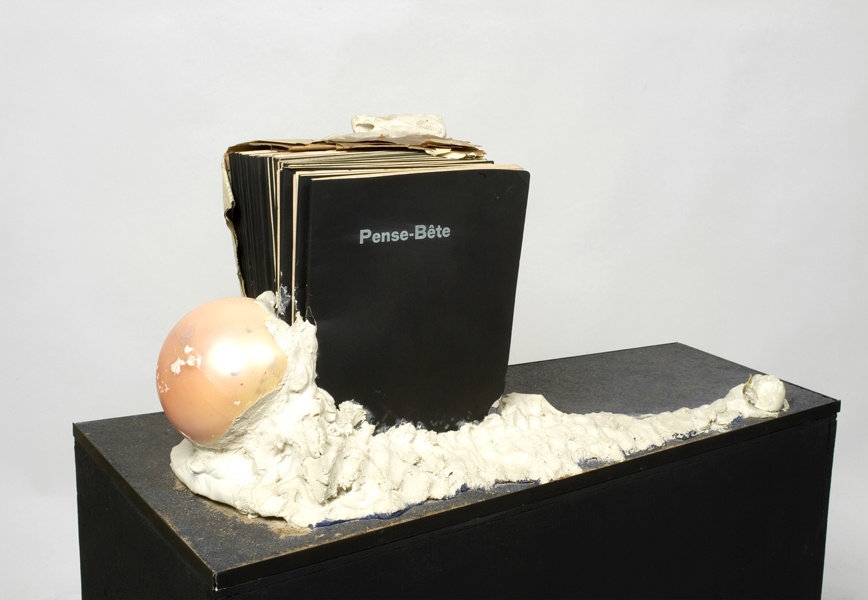
As late as the second half of the 1980s, Buchloh observed that the literary quality of Broodthaers’s art was hampering the institutional recognition of the Belgian artist’s practice. Broodthaers was regarded as a “mere” littérateur rather than a real artist. Since then, the values bound up with this distinction have been inverted: Broodthaers’s œuvre is now prized precisely for its literary qualities. But what has made the “artist poet” model so attractive in recent years, and what are its downsides? As I have argued above, the poetic procedure can be a form of resistance to the instrumentalist yearning for disambiguation, especially since it opposes the general tendency to press art into the service of communicating certain messages and meanings. Further, “poetry” is still associated with a purer form of art, one less compromised by market circumstances – even if, as Broodthaers never tired of highlighting, the opposite is actually true. On the one hand, his œuvre points to how there was no money in volumes of poetry, which is why he demonstratively embedded his published poems in plaster (“Pense-bête,” 1964), making them largely illegible. On the other hand, “Pense-bête” was a way of transforming his poetical writing into a sculptural object, a unique product with obvious market potential. We encounter similar efforts in many projects today, as in the works of numerous artist-poets who, like Karl Holmqvist or Anne Imhof, translate their poems or handwritten notes into marketable singular pictures.
But I would also argue that the “artist-poet” model implies an anti-critical thrust, and in this regard, too, Broodthaers is a model case. He sometimes made disparaging remarks about criticism or trained his sharp wit on critics such as Michel Tapié. The “seeming engagement of people like Godard,” he once said, “disturbed” him. On the other hand, Broodthaers had worked as a critic for a while, writing reviews on shows of Pop and other contemporary art – perhaps one reason behind the vehemence with which he distanced himself from critical gestures. Consider, too, the formal aesthetic resemblance his films bear to Godard’s, which integrate text in comparable ways – an affinity Broodthaers obviously felt the need to disavow.
At a time when critique is widely experienced as “tyrannical” (Timothy Brennan), this anti-critical attitude falls on fertile ground. Most recently, this year’s Berlin Biennale has been associated with a turning away from criticism since it supposedly distanciated itself in particular from the “critical theory” that is allegedly being taught at the majority of art schools. Never mind that this idea of criticism’s supposed hegemony is pure fantasy: today’s bashers of critique also never tire of arguing, in a narrowly functionalist perspective, that it is mere grist to the system’s mill. Granted that it does, of course, play a part in the production of value, as Broodthaers already pointed out in “100%/100% Ordres de bourse,
La banque” (1967), in which the critic Otto Hahn’s silhouette appears next to a relief-like bank counter. So it certainly can supply the symbolic value that underlies market values – but the all-important question remains: How does criticism actually construct its arguments? There is no denying that it participates in market conditions; still, it can make a vital contribution by drawing distinctions, analyzing art in its economy, breaking the spell of immediate impressions, producing value judgments, and thus creating the conditions in which change becomes possible.
What is more, the anti-critical self-image is part and parcel of dandyism as embodied by, for example, Monsieur Teste, the protagonist of the eponymous 1896 novel by Paul Valéry, one of Broodthaers’s heroes. As Valéry puts it succinctly, Teste, an occasional stock-market speculator, has “no opinions.” In Broodthaers, too, the dandyish eschewal of personal opinion, programmatic demands, and critical articulation does not imply disregard for the market’s realities. On the contrary, he is an insistent analyst of art’s – and the artist’s –adaptation to the commodity form, anticipating the critique of the economy of art that today’s much-maligned art criticism, at least in an ideal scenario, still undertakes. What is written large in Broodthaers’s œuvre is the semiotic indeterminacy of Symbolist poetry, and this lends his project an anti-critical edge of the sort that can be especially praised in a climate opposed to criticism. But his œuvre also reminds us that the “artist-poet” is by no means less compromised than, say, the painter producing on-demand works for art fairs. He caters to the romantic desire for a more “pure” and poetic art that turns out, upon closer inspection, to be commodified through and through.
Isabelle Graw
Translation: Gerrit Jackson
Notes






